It’s crucial for businesses to maintain an active, useful social media presence to compete and grow. No modern social strategy is complete without Instagram. It’s a top destination for brands, creators, and consumers—and a powerful engine for discovery, community, and sales when you use it intentionally.
The Instagram platform has 2.35 billion monthly active users. Here’s something else that may surprise you: 70% of Instagram hashtags are branded.
What does that tell you? If you’re not active on Instagram, your competitors definitely are—and they’re earning attention, conversations, and clicks that could have been yours.
Having a profile is a start, but profiles don’t convert by themselves. If you want Instagram to drive real revenue, you need a clear plan that attracts the right audience, earns trust with helpful content, and makes buying or contacting you effortless.
This post will steer you in the right direction with 18 practical tips you can put to work in your Instagram marketing strategy today.
Let’s begin.
1. Increase your following
Growing a high-quality follower base is the foundation of a successful Instagram strategy. Focus on people who actually match your customer profile—not random follows—and give them clear reasons to stick around.
Without a healthy, engaged audience, your posts won’t reach enough people to impact sales. If you’ve just launched your page, don’t be discouraged by starting at zero. Unless you’re brand new, you already have customers and subscribers—invite them first.
More than 73% of users follow brands because they’re interested in what those brands offer. Start with your warm audience: announce your Instagram in email, at checkout, in your app, and on receipts and packaging. Give a concrete incentive to follow—exclusive drops, limited-time promo codes in Stories, early access, or behind-the-scenes content.
Follow through on the promise. If you say “follow us for weekly tips and Story-only deals,” deliver consistently. Add an Instagram badge to your website header and footer, and cross-promote your profile on your other social channels.
To find new, relevant followers, don’t mass-follow randomly. Identify adjacent accounts and communities whose audiences overlap with yours, then engage thoughtfully: comment with value, answer questions, and join conversations. If you sell hiking and camping gear, for example, you could engage with accounts like Adventure Enthusiasts:—their followers are likely your people.
It takes effort, but it works. When those users check your profile and immediately understand who you are and how you help (more on that next), follow-backs rise. Combine this with collaboration posts (where content appears on both your feed and a partner’s), strategic giveaways, and creator partnerships to accelerate growth.
2. Focus on the first impression of your page
First impressions matter online just as much as they do offline. When someone lands on your profile, they decide in seconds whether to follow or leave. Make those seconds count.
Visitors see your profile photo, bio, category, contact buttons, link, and your most recent posts. Remove confusion. Your bio should say who you are, what you offer, and why someone should follow—all in plain language. Use your logo for the profile pic to boost recognition, and choose a category that matches your business so users (and Instagram search) can instantly understand your focus.
Here’s an example from the Dollar Shave Club Instagram page:
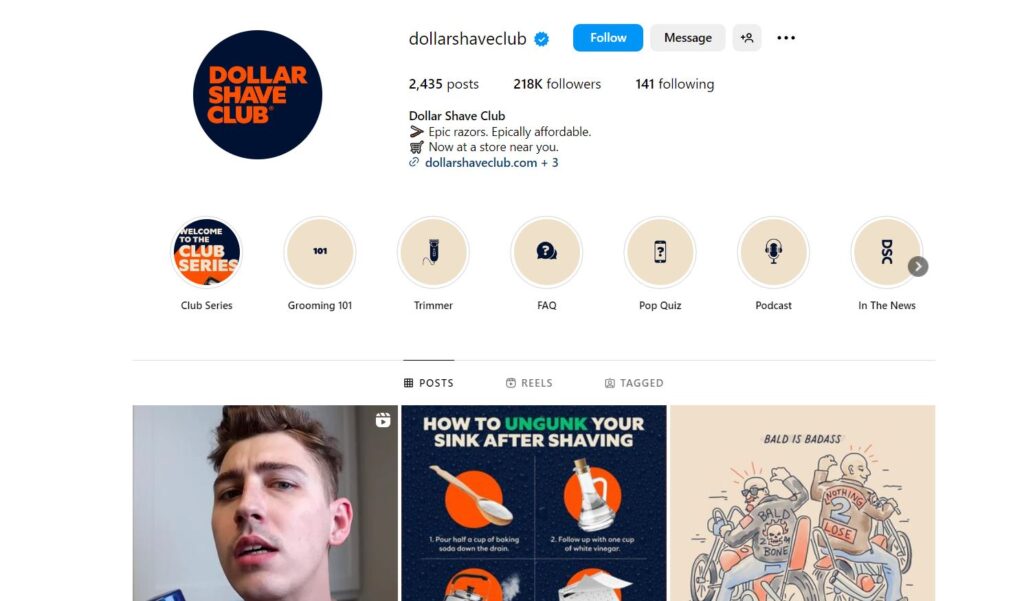
It’s clear who they are and what they do. Add a strong call to action in your bio and use your link to drive to a landing page (or link hub) aligned with current campaigns. Pin up to three posts to showcase your top offer, social proof, or a “Start Here” guide. Keep everything short, skimmable, and on-brand—that’s how you convert profile views into followers and customers.
3. Post content on a regular basis
One post a month isn’t an active strategy. Stay present so your brand is top of mind, but don’t overwhelm people. Aim for consistency over volume.
A practical baseline: 3–5 feed posts per week (mixing Reels, carousels, and photos), daily Stories on weekdays, and 1–3 Reels per week. If you have more quick updates, use Stories instead of flooding the feed.
Timing matters, but there’s no one “magic hour.” Use Insights to see when your audience is most active and schedule content accordingly. Test midday and evening windows, and adjust based on reach and watch time. When you have multiple pieces in a day, anchor the feed post and support it with Story reminders rather than stacking feed posts back-to-back.
Top brands post during typical work hours because people browse during breaks. But let your data guide you—post regularly, review performance weekly, and keep iterating.
4. Don’t be too “salesy”
Yes, you want sales. But if every post screams “Buy now,” people tune out. Rotate content types so your feed feels like a helpful, interesting magazine—not an endless ad.
Mix product highlights with educational tips, tutorials, before/after transformations, customer stories, cultural moments relevant to your brand, and behind-the-scenes peeks. Keep humor and personality, but stay aligned with your brand voice. Avoid hot-button topics (politics, religion, race) that can distract or alienate your audience.
Users cite “too many promotions” as a top reason they unfollow. When you do promote, be concise, clear, and respectful—no ALL CAPS, no spammy punctuation. Lead with the benefit, show proof, add a simple CTA, and let your creative do the heavy lifting.
5. Go live
Live video builds real-time connection. Use Instagram Live to host AMAs, product demos, expert interviews, drops, and community check-ins. Encourage questions, shout out viewers by name, and save the Live to your profile for on-demand viewing.
Plan a simple run of show (intro ? value/demo ? Q&A ? CTA). Invite creators or partners to co-host—collaborative Lives notify multiple audiences at once. Afterward, clip highlights into Reels and Stories to extend reach.
Even a 15-minute Live can move people closer to purchase by deepening trust and addressing objections in the moment.
6. Add pictures and videos to your story
Stories are perfect for daily touchpoints: quick tips, polls, countdowns, limited-time offers, and behind-the-scenes updates. They disappear after 24 hours, so keep them timely and focused.
Use interactive stickers (polls, quizzes, questions) to spark replies and DMs. Add link stickers to drive traffic directly to product pages, a sign-up form, or longer content. Don’t overload—audience drop-off rises with each additional frame—so aim for high-signal sequences and save your best evergreen Stories to Highlights (“Shop,” “How It Works,” “Reviews”).
Story takeovers with complementary brands or creators can expose you to entirely new audiences in a single day.
7. Partner with social influencers
Creators influence purchase decisions because they’ve earned trust. Partner with micro and mid-tier creators (10k–100k followers) who genuinely use products like yours and whose audiences match your target customer.
Give creators clear briefs (key benefits, dos/don’ts, deadlines) but allow creative freedom so the content feels native to their style. Use collaboration posts so the content appears on both feeds, and have creators tag products in their posts. Always require FTC disclosures (e.g., “#ad”), and clarify content usage rights so you can repurpose creator assets in ads and on your site.
These partnerships are often more cost-effective than traditional ads and can generate stronger engagement and conversion—especially when tied to a trackable code or link.
8. Add hashtags to your captions
Captions carry context, keywords, and calls to action. Write for humans first—hook attention in the first line, deliver value, and end with a simple next step (comment, save, click, DM).
Use hashtags strategically. Choose a small set of highly relevant tags rather than stuffing dozens. Combine branded, niche, and location hashtags to aid discovery. Just as important in 2025: weave plain-language keywords into captions so you’re more likely to appear in Instagram search and suggested content.
You’ve got to learn how to write Instagram captions that drive engagement. Add alt text to images for accessibility (and subtle SEO), and geotag posts when location matters.
For national moments, you can tap into an existing hashtag. Or create your own brand/campaign tag and encourage customers to use it when they share.
If you’re like to run contests on Instagram, create a unique hashtag for each one so entries are easy to find and feature.
9. Encourage UGC
UGC—user-generated content—is social proof in action. Contests and prompts nudge customers to share photos and videos of your products in the wild. This exposes your brand to their friends and followers and acts like a trusted recommendation.
Feature UGC regularly on your feed and Stories (with permission). Create a simple spotlight cadence: weekly “Customer of the Week,” monthly roundups, or themed galleries. Clearly state how to be featured (your branded hashtag, tagging your handle, or replying to a Story prompt), and save featured posts to a Highlight.
Check out this post from the Thule Instagram page:
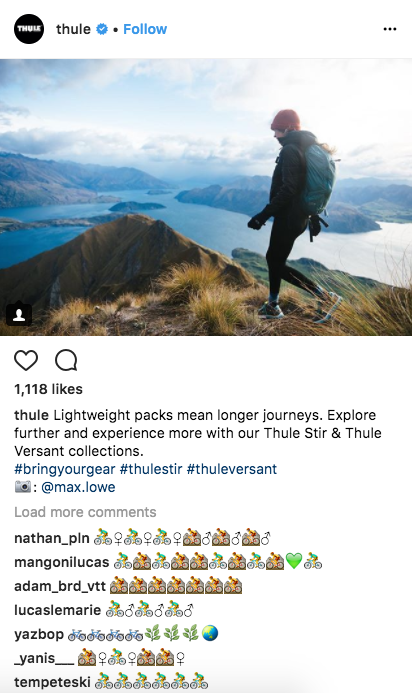
When others see real customers spotlighted, they’re more likely to share their own content—and more likely to trust you.
10. Run targeted ads
To reach people beyond your followers—especially buyers who fit your ideal customer—run Instagram ads through Meta Ads Manager. Build audiences based on interests, behaviors, demographics, and first-party data (site visitors, email lists), and use lookalikes to scale.
Match format to goal: Reels and Story ads for reach and engagement, carousel and collection ads for browsing, and product-tagged image/video for shopping. Pair thumb-stopping creative with a single, clear CTA. Test variations weekly and let high performers absorb more budget.
Here’s an example from Tentree:

Ads that look and feel native to the feed tend to perform best. If budget allows, test dynamic product ads that pull from your catalog and retarget recent visitors—great for nudging shoppers back to items they viewed.
11. Run contests and giveaways
Giveaways and contests spark attention, grow followers, and create content you can reuse. Done well, they also move people closer to purchase.
If you can learn how to run a profitable giveaway, your efforts will result in more sales. Partner with complementary brands to pool audiences and build bigger prize bundles. Require lightweight actions (follow, like, save, comment, use your hashtag) and make the rules crystal clear. Announce winners publicly, then offer all entrants a time-limited discount to capture momentum.
Contests that encourage UGC (post & tag your product in use) generate the most authentic reach. Always include eligibility, timing, and how the winner is chosen, and follow Instagram’s promotion guidelines.
Now that your brand is top of mind, your follow-up offer will convert more of those engaged entrants into customers—even if they didn’t win.
12. Use link stickers in Stories (formerly “swipe up”)
The old “swipe up” has been replaced with link stickers—available to all accounts—making it much easier to drive traffic from Stories directly to landing pages, sign-up forms, or product pages.
For years, sending users to “link in bio” added friction. Now, add a link sticker to the relevant Story frame, write a compelling reason to tap, and track results with UTM parameters. Pair the link with countdowns for launches, limited-time codes, or restock alerts to increase urgency.
Once your business profile reaches 10k followers, you’ll have access to this feature.
Just promote a product or service on your story, and add the link sticker that goes straight to the landing page you want people to see. Keep the path short: tap ? page ? add to cart or sign up.
These direct paths reduce drop-off and increase conversions from mobile traffic.
13. Use shoppable posts
If you sell online, use product tagging so people can tap to see details and buy. Shoppable posts lower friction—your audience is already browsing Instagram daily, so meet them where they are.
Tag products in feed posts, Reels, and Stories. In regions where it’s supported, Checkout on Instagram lets customers complete a purchase without leaving the app; otherwise, product taps take shoppers to your site’s product page.
Here’s an example from Patara Shoes:
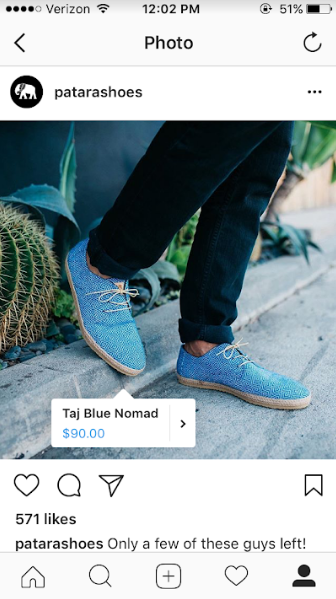
Use product tags plus persuasive captions and social proof (reviews, UGC). Create urgency ethically—limited stock, limited colors, or a seasonal drop—to nudge action.
14. Post the same product more than once
Most people won’t buy the first time they see a product. Plan a content arc that revisits the same item from different angles over several weeks.
Start with a teaser Reel, follow with a carousel detailing benefits, share UGC using the product, run a time-limited offer in Stories, and finish with a FAQ or “how to style/use” post. That sequence keeps interest high without repeating the exact same creative.
According to research, many people need multiple touchpoints before purchasing. Revisit winners periodically—new followers haven’t seen last month’s hit, and returning visitors may be ready now.
15. Respond to comments and messages
Replying to comments and DMs adds a human layer your audience remembers. It also boosts your visibility—engaged posts are more likely to be shown to others.
Answer questions, acknowledge feedback, and solve problems quickly. Save replies to common questions (shipping times, sizing, warranties) to speed up response time. For high volume, set up automated greetings and FAQs in Instagram’s messaging tools so customers get instant help while you handle complex cases personally.
Great service is a differentiator. When people see responsive support publicly, it reinforces trust—and trust drives sales.
16. Use your story to showcase products
Stories are ideal for product spotlights. Use product stickers and link stickers to connect each frame directly to a buy page. Keep copy short and visual first, and include a clear CTA (“Tap to shop,” “Tap for the size guide”).
Here’s a look at an example from Madewell:
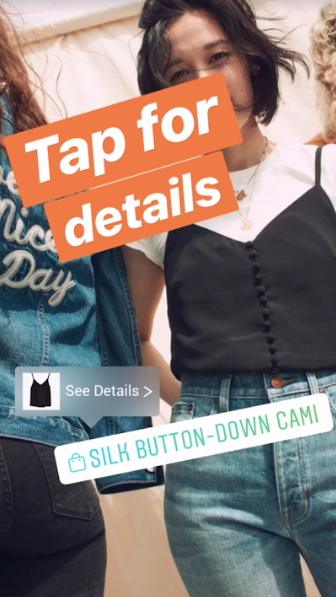
As you can see, the post is promoting a silk button-down cami.
Since the shopping feature on stories is new, the post features additional text as a way to tell the users the post is clickable.
If you tap on the button as instructed, you’ll be redirected to the brand’s website. From here, you’ll have an option to buy the product displayed in the story:
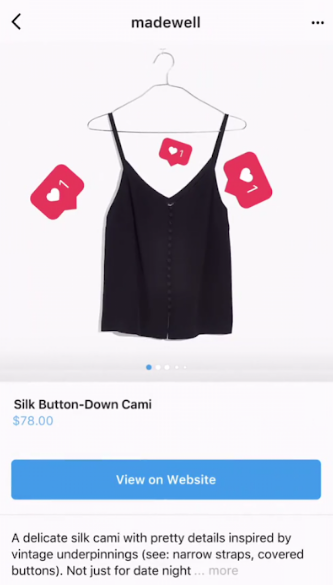
Bundle related products into a Story series, add a countdown for a drop, and save the whole set to a “New In” Highlight so shoppers can revisit anytime.
17. Connect your followers to your Facebook page
If your company has an Instagram profile, it probably also has a Facebook page. Since Instagram is part of Meta, cross-posting and audience tools work together.
Sync your accounts so you can cross-post content, unify your ad campaigns, and build audiences based on engagement across both platforms. Use messaging tools and approved partners to automate simple responses in Instagram DMs while keeping complex conversations human. If WhatsApp is popular with your audience, add that as a contact option, too.
The result: wider reach from the same creative and faster customer support—from whichever app your customers prefer.
18. Offer discounts to your followers
Everyone loves a good deal. Share follower-only promo codes, Story flash sales, and exclusive bundles to reward your community and drive action.
Instagram is great for limited-time offers. Because Stories disappear after 24 hours, they create natural urgency—announce the code at the start of the Story and repeat it in the final frame with a link sticker to the product or category page.
Look at how J. Crew offered a discount in this post:
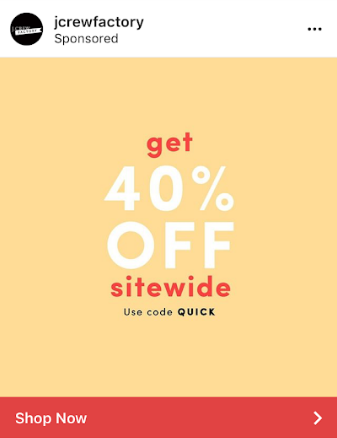
Combine the offer with targeted ads to reach qualified non-followers. Ads include CTA buttons (“Shop Now,” “Sign Up”) that take users directly to your site, reducing friction. Track codes with UTMs so you can see which formats and audiences convert best and double down on winners.
Conclusion
You can’t rely on website traffic alone to sell. Instagram gives you multiple levers—discovery (Reels, hashtags, search), trust (UGC, creator content, Lives), and seamless paths to purchase (product tags, link stickers, targeted ads).
Social media directly influences what people buy. With Instagram’s massive reach and commerce features, it should be a primary channel in your marketing mix.
If your Instagram strategy needs a refresh, work through these 18 steps. Optimize your profile, post consistently, diversify your content, make buying easy, and be relentlessly helpful in your replies.
Do that, and you’ll grow a healthier audience, earn more engagement, and turn more of that attention into sales.
